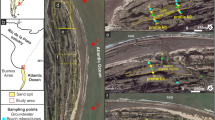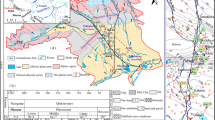Abstract
The hyporheic zone plays an important role in groundwater and stream water quality protection. To investigate the stream-groundwater interaction mechanisms in the lateral hyporheic zone, this study examined Ma’an Creek in Chongqing during the dry season from December 2015 to April 2016. The water level, water temperature, pH and Cl− concentration in the hyporheic zone and groundwater were monitored in situ. The sediment permeability coefficient, stable isotopes of hydrogen and oxygen and concentration of DOC were analyzed. The results show that the water level changes of hyporheic zone and the movement of hyporheic flow were influenced significantly by the permeability coefficient of sediment. The hyporheic flow approximately 10 cm from the stream bank was clearly affected by precipitation infiltration and evapotranspiration. During the study period, the groundwater recharged the stream, and the impact of groundwater on the hyporheic flow gradually decreased with the flow path. The hyporheic flow approximately 30 cm from the stream bank was still mainly affected by groundwater. Approximately 10–30 cm from the stream bank, the mixing of groundwater with precipitation and stream water intensified. Due to the sediment properties, moisture accumulated approximately 10 cm from the stream bank and drained into the stream via hyporheic flow, with potential impacts on stream water quality.
Similar content being viewed by others
References
Aleksander-Kwaterczak U, Ciszewski D. 2016. Pollutant dispersal in groundwater and sediments of gaining and losing river reaches affected by metal mining. Environ Earth Sci, 75: 95
Aseltyne T A, Rowe H D, Fryar A E. 2006. Stable isotopic fingerprint of a hyporheic-hypolentic boundary in a reservoir. Hydrogeol J, 14: 1688–1695
Boulton A J, Findlay S, Marmonier P, Stanley E H, Valett H M. 2003. The functional significance of the hyporheic zone in streams and rivers. Annu Rev Ecol Syst, 29: 59–81
Boulton A J, Datry T, Kasahara T, Mutz M, Stanford J A. 2010. Ecology and management of the hyporheic zone: stream-groundwater interactions of running waters and their floodplains. J North Am Benthol Soc, 29: 26–40
Butturini A, Bernal S, Sabater S, Sabater F. 2002. The influence of riparian-hyporheic zone on the hydrological responses in an intermittent stream. Hydrol Earth Syst Sci, 6: 515–526
Chandler I D, Guymer I, Pearson J M, van Egmond R. 2016. Vertical variation of mixing within porous sediment beds below turbulent flows. Water Resour Res, 52: 3493–3509
Chen X B, Zhao J, Li Y Y, Chen L. 2014. Experimental study of bedform-driven hyporheic exchange (in Chinese). Adv Water Sci, 25: 835–841
Dansgaard W. 1964. Stable isotopes in precipitation. Tellus, 16: 436–468
Duke J R, White J D, Allen P M, Muttiah R S. 2007. Riparian influence on hyporheic-zone formation downstream of a small dam in the Blackland Prairie region of Texas. Hydrol Process, 21: 141–150
Fischer H, Kloep F, Wilzcek S, Pusch M T. 2005. A river’s liver-microbial processes within the hyporheic zone of a large lowland river. Biogeochemistry, 76: 349–371
Gan X Y. 2012. The study on the urban vally type of wetland landscape restoration and reconstruction, a case study on Maan creek wetland park in Chongqing (in Chinese). Dissertation for Master Degree. Chongqing: Southwest University. 39–48
Hartwig M, Borchardt D. 2015. Alteration of key hyporheic functions through biological and physical clogging along a nutrient and fine-sediment gradient. Ecohydrology, 8: 961–975
Herzog S P, Higgins C P, McCray J E. 2015. Engineered streambeds for induced hyporheic flow: Enhanced removal of nutrients, pathogens, and metals from urban streams. J Environ Eng, 142: 04015053
Huber E, Huggenberger P. 2015. Subsurface flow mixing in coarse, braided river deposits. Hydrol Earth Syst Sci Discuss, 12: 9295–9316
King A C, Raiber M, Cendon D I, Cox M E, Hollins S E. 2015. Identifying flood recharge and inter-aquifer connectivity using multiple isotopes in subtropical Australia. Hydrol Earth Syst Sci, 19: 2315–2335
Krause S, Hannah D M, Fleckenstein J H, Heppell C M, Kaeser D, Pickup R, Pinay G, Robertson A L, Wood P J. 2011. Inter-disciplinary perspectives on processes in the hyporheic zone. Ecohydrology, 4: 481–499
Lasagna M, De Luca D A, Franchino E. 2016. Nitrate contamination of groundwater in the western Po Plain (Italy): The effects of groundwater and surface water interactions. Environ Earth Sci, 75: 240
Li T Y, Li H C, Shen C Z, Yang C X, Li J Y, Yi C C, Yuan D X, Wang J L, Xie S Y. 2010. Study on the δD and δ18O characteristics of meteoric precipitation during 2006–2008 in Chongqing, China (in Chinese). Adv Water Sci, 21: 757–764
Li Z J. 1983. Agrogeological characteristics of red beds in Sichuan basin (in Chinese). Discov Nat, 5: 85–96
Maloszewski P, Moser H, Stickler W, Bertleff B, Hedin K. 1987. Modelling of groundwater pollution by river bank filtration using oxygen-18 data. In: International Symposium on Groundwater Monitoring and Management. Institute of Water Management/UNESCO. 153–161
Mendoza-Sanchez I, Phanikumar M S, Niu J, Masoner J R, Cozzarelli I M, McGuire J T. 2013. Quantifying wetland-aquifer interactions in a humid subtropical climate region: An integrated approach. J Hydrol, 498: 237–253
Menichino G T, Hester E T. 2015. The effect of macropores on bi-directional hydrologic exchange between a stream channel and riparian groundwater. J Hydrol, 529: 830–842
Miller R B, Heeren D M, Fox G A, Halihan T, Storm D E. 2014. Heterogeneity influences on stream water-groundwater interactions in a gravel-dominated floodplain. Hydrol Sci J, 61: 741–750
Packman A, Brooks N. 1995. Colloidal particle exchange between stream and stream bed in a laboratory flume. Mar Freshw Res, 46: 233–236
Pezdicč J. 1997. Recharge and retention time study of a partly karstified Area of Boč (Eastern Slovenia) using Hydrogen, Oxygen and Carbon isotope composition as natural tracers. Isot Environ Health Stud, 33: 293–306
Shan X Z, Wei Y Q, Yan H J, Liu J F, Zhang R. 1998. Influence of organic matter content on soil hydrodynamic parameters (in Chinese). Acta Pedol Sin, 35: 1–9
Song X, Liu X, Xia J, Yu J, Tang C. 2006. A study of interaction between surface water and groundwater using environmental isotope in Huaisha River basin. Sci China Ser D-Earth Sci, 49: 1299–1310
Stewardson M J, Datry T, Lamouroux N, Pella H, Thommeret N, Valette L, Grant S B. 2016. Variation in reach-scale hydraulic conductivity of streambeds. Geomorphology, 259: 70–80
Su X, Xu W, Du S. 2014. In situ infiltration test using a reclaimed abandoned river bed: Managed aquifer recharge in Shijiazhuang City, China. Environ Earth Sci, 71: 5017–5025
Templar H A, Dila D K, Bootsma M J, Corsi S R, McLellan S L. 2016. Quantification of human-associated fecal indicators reveal sewage from urban watersheds as a source of pollution to Lake Michigan. Water Res, 100: 556–567
Wagner F H, Bretschko G. 2003. Riparian trees and flow paths between the hyporheic zone and groundwater in the Oberer Seebach, Austria. Internat Rev Hydrobiol, 88: 129–138
West A G, February E C, Bowen G J. 2014. Spatial analysis of hydrogen and oxygen stable isotopes (“isoscapes”) in ground water and tap water across South Africa. J Geochem Exploration, 145: 213–222
Xia J H, Chen Y M, Wang W M, Han Y L, Liu H Y, Hu L. 2013. Dynamic processes and ecological restoration of hyporheic layer in riparian zone (in Chinese). Adv Water Sci, 24: 589–597
Xie M, Wang N, Gaillard J F, Packman A I. 2016. Hydrodynamic forcing mobilizes Cu in low-permeability estuarine sediments. Environ Sci Technol, 50: 4615–4623
Yin G, Mi S J, 2009. Isotope Geochemistry (in Chinese). Beijing: Geological Publishing House. 30–37, 259–260
Yu Z B, Huang Y, Franklin W S. 2008. Fundamentals of Groundwater Hydrology (in Chinese). Beijing: Science Press. 75–76
Zhang X, Deng Z M, Pan G Y, Wu S F, Xiao Y, Zhu C R. 2015. Variation in stable isotope composition in soil water in Poyang Lake Wetland (in Chinese). Acta Ecol Sin, 35: 7580–7588
Zhang Y, Yang P H, Wang J L, Xie S Y, Chen F, Zhan Z J, Ren J, Zhang H Y, Liu D W, Meng Y K. 2016. Geochemical characteristics of lateral hyporheic zone between the river water and groundwater, a case study of Maanxi in Chongqing (in Chinese). Environ Sci, 37: 2478–2486
Acknowledgements
We thank Zhe Sun, Haiyue Zhang, Xinru Zeng, Mei Zhang, Jingli Zhou, Li Li, Jiaqi Lei, Feng Chen, Zhaojun Zhan, and Tong Qin for their help with field sampling and laboratory works. This work was supported by the National Key Technology R&D Program of China (Grant No. 2011BAC09B01), Fundamental Research Funds for the Central Universities (Grant Nos. XDJK2014A016 & XDJK2016D046) and Scientific and Technical Innovative Program of graduate students in Chongqing (Grant No. CYS16050).
Author information
Authors and Affiliations
Corresponding author
Rights and permissions
About this article
Cite this article
Zhang, Y., Wang, J., Yang, P. et al. Movement of lateral hyporheic flow between stream and groundwater. Sci. China Earth Sci. 60, 2033–2040 (2017). https://doi.org/10.1007/s11430-016-9103-9
Received:
Accepted:
Published:
Issue Date:
DOI: https://doi.org/10.1007/s11430-016-9103-9




